A heritage purposely erased since the Nakba of 1948.
Gabriel Polley
Not long after we had alighted from the service — bright yellow people-carriers that shuttle the carless around Palestine — in the village of Deir Ghassaneh, we were accosted by a solitary boy patrolling the otherwise deserted streets. Not unreasonably, he wanted to know what my traveling companion and I were doing in his village, nestled amongst the olive-terraced mountains and valleys of the northern West Bank, well off most sightseers’ beaten track. “Al-Khawwas?” he replied, slightly incredulously, when we asked for directions. “That way,” he indicated with a tilt of his head.
We thanked the boy, and started walking. It was early autumn, and the midday sun had lost little of its summer heat. But in the center of the village, the shaded pathways between the medieval mansions built by the village’s Barghouthi clan kept the temperature cool.

The heat increased as we headed westwards, along a dusty road between single-story homes built during the British and Jordanian occupations, interspersed with purple splashes of bougainvillea, pomegranate orchards and groves of gnarled olive trees — the mute observers of the rise and fall of Palestine’s succession of occupiers. Finally, as the path rose towards a hilltop, a low building of roughly-cut stone blocks, surmounted by twin domes covered by fading pink plaster, came into view. It was the shrine, or maqam, of al-Khawwas.
The word maqam, deriving from the Arabic root qam, signifies place, in this case a particular place considered sacred through its association with a saint, who may have chosen it as their spiritual retreat from the world, or is believed to have been buried there; from the same root comes the word maqam, signifying melodic modes in Arabic music. The maqam shrine of Palestine is a part of a heritage that has been purposefully erased since the Nakba and ethnic cleansing of Palestine of 1948. Arab Palestine has been replaced by the Jewish State of Israel, or the “Holy Land,” a clutch of sacred sites in Jerusalem, Bethlehem and the Galilee, with the Gaza Strip and West Bank relegated to loci of suffering and brutality rather than humanity and steadfastness under oppression. Who now, hearing the words Palestine or Holy Land, thinks of ancient shrines on serene hillsides?
As happens so often in Palestine, the new jostles uncomfortably with the old: the Deir Ghassaneh police station belonging to the Palestinian Authority squats shortly beneath the summit crowned by al-Khawwas’ maqam. Past this unasked-for reminder of the Oslo Accords of the 1990s, and a “peace process” which had only entrenched occupation, was a small park surrounding the maqam. There was an almost eerie silence on the hilltop, broken only by the soft whistling of the wind along deep valleys ridged with terraces of silver-green olive trees.
Inside the park’s entrance was a memorial to those from Deir Ghassaneh who had fallen in Palestine’s freedom struggle. The locations and dates of their martyrdoms reveal the history of the movement: from Jordan in the late 1960s and early 1970s as the Palestinian Liberation Organization waged armed struggle against both the State of Israel and the Hashemite Kingdom of Jordan; to Lebanon in 1978, with Israel’s first occupation of the south of the country; and then Deir Ghassaneh itself in the late 1980s and the 2000s, when the Gaza Strip and West Bank rose up in the first and second Intifadas. A site of Palestinian spiritual heritage and religious pilgrimage or ziyara had become a place to visit and remember Deir Ghassaneh’s martyrs.

Kiosks stocked with shisha pipes, and chairs in the shade of cypress, eucalyptus and other trees inured to the heat, showed that it was also a place where locals came to relax on pleasant summer evenings. However, the original spiritual meaning of the maqam had not been forgotten. A sign informed us that the maqam was dedicated to:
Sheikh Abu Ishaq Ibrahim ibn Ahmad ibn Ismail Al-khawass al-Samarrai, born in Samarra’ and died at Alray (Iraq) in 904 A.D. […] The Khawass name is ascribed to the fact that the Sheikh used to work in the manufacturing of baskets and tools from wicker or palm fronds.
An Islamic prayer mat inside the maqam’s cool, dim chamber revealed that the maqam was still used as a space to devote to the divine.
In Palestine, many shrines have been purposefully erased or expropriated. These include many demolished by Israel after the Nakba, such as the maqam where the head of the Prophet Muhammad’s grandson Hussein was once interred, in the town of Asqalan north of Gaza, to which Asqalan’s residents were expelled as refugees. North along the coastal road, in the destroyed village Yibna, is a maqam repurposed as an exclusively Jewish religious site. Now in the Israeli town Yavne, the maqam of Abu Huraira, a seventh-century companion of the Prophet, is used to commemorate the first-century Jewish priest Rabban ben Gamliel. “Abandoned and decaying,” as Walid Khalidi writes, other shrines remain dotted around historic Palestine to “bear witness to villages which have now almost disappeared.”
Only a few remain accessible as places of spiritual practice for Palestinians living in ‘48, the term they use for the State of Israel which freezes time at the moment of the Nakba. The Israeli press has tried to depict shrines as “part and parcel of the Israeli landscape,” legacies of Palestine’s foreign rulers rather than authentic spiritual expressions of the Indigenous population which remained as invaders came and went.
In territories Israel occupied in 1967, shrines have been similarly threatened. The occupation’s settlements, checkpoints and apartheid wall, which render much of the West Bank out of bounds to the Palestinians who call it home, mean that no less than forty shrines are inaccessible. On once-sacred hilltops, shrines slowly crumble as they sit amidst Jewish-only settlements. Shrines to Biblical figures, including Jacob’s tomb in Nablus and Rachel’s tomb in Bethlehem, are barred to the Palestinians who live meters away, while the Israeli military facilitates visits of abusive and violent settlers during Jewish festivals. In Deir al-Balah in the central Gaza Strip, a maqam to the Prophet al-Khidr was renovated as a cultural center; it is among hundreds of archaeological sites bombed by Israel since October.
Why has Israel been so concerned with destroying these shrines, or claiming a Jewish origin for them counter to evidence? I think it’s this: Zionist propaganda has attempted to de-indigenize Palestinians, denying their connection to the land by comparison with Jews. The maqam, often many centuries old, represents not only Palestinians’ unbroken presence on the land, but also their spiritual connection to it, ascribing sacredness not just to a cluster of holy sites, but to innumerable places the length and breadth of the land. It shows that the connection of Muslim and Christian Palestinians to their country is no less significant than the Jewish affinity for the Holy Land, and continued to develop over centuries, as generations of holy men and women became associated with locales in the landscape —in his 1927 book, Mohammedan Saints and Sanctuaries in Palestine, Palestinian ethnographer Tawfiq Canaan reported that just over a tenth of the shrines he visited were dedicated to women, but also that “the greater part of them are of some importance, 60 per cent of the female saints enjoying a wide reputation, as compared to only 31 per cent of the male list.
Western visitors to Palestine took close notice of the shrines as well. In his book Tent Work in Palestine, Claude Reignier Conder (1848–1910) recorded his journey to the Eastern Mediterranean in the 1870s for the Palestine Exploration Fund — a British organization in which Evangelical Christians’ Holy Land obsession converged with a covert colonial agenda. “In almost every village in the country,” he wrote, “a small building surmounted by a whitewashed dome is observable, being the sacred chapel of the place.” While he expressed interest in shrines to Biblical figures, those honoring later Islamic saints (awlia, singular wali), he dismissed as “of but little importance.” With the arrogance of the Western Orientalist, he went on to write, “The stories usually related of the Sheikhs are neither interesting in themselves, nor do they apparently conceal any mythological meaning … In the main the stories are childish.”
Ultimately, Conder tried to use the shrines to demonstrate the static nature of non-Western societies and Palestinians’ supposed similarities with their ancient forebears: “The worship of local personal divinities by the peasantry reminds one strongly of the ancient cultus of the Canaanite tribes.” Given Conder’s later support for the Zionist movement, it’s reasonable to assume that his view of the shrines influenced his belief in Palestinians’ inferiority to Jewish settlers, just as in the Biblical narrative the Canaanites were supplanted by the Israelites.
More recent scholars have redressed such prejudiced views. James Grehan describes the religious culture that produced the maqam as “subtle and flexible and open to discreet adaptation and invention, disguised and legitimated with pious references to ancestral tradition (whose very invocation is often a sign of historical change).” And in comparison with mainstream understandings of the Abrahamic faiths, particularly Islam, prevalent today, the rural shrines of Palestine evoke “a wider, weirder field of piety, belief, and prayer that throws all our conventional conceptions of religion into doubt and confusion.”
The researcher most closely identified with the Palestinian maqam is Tawfiq Canaan (1882–1964). The life of the Arab Christian medical doctor with a fascination in the Islamic folk religion of Palestine spanned the final years of the Ottoman Empire, the First World War, British occupation, and the Nakba and its aftermath. Canaan’s seminal work, Mohammedan Saints and Sanctuaries in Palestine, contains his descriptions and analysis of hundreds of shrines he visited and researched.
The Palestine which he scientifically but also lyrically describes is one of sacred trees and springs, often haunted by friendly or malign spirits; of songs sung by village children to implore the Almighty to end droughts and send the seasonal rains; and, of course, of shrines, where ziyara could be made to offer a sacrificial animal or other agricultural produce in return for a longed-for child or other piece of good fortune. But also, it was believed, this was where the ghosts of long-dead prophets and saints could gather on Thursday nights for dhikr (remembrance of God), the sound of their ethereal chanting and eerie green light emanating from the maqam startling any late passers-by.
Such beliefs were, Canaan wrote in 1927, “disappearing so quickly that before long most of them will be forgotten,” as a result of “the great influences which the West is exerting upon the East, owing […] above all, to the influence of the [British] Mandatory Power.”
Changing religious norms, resulting mainly from the social trauma and dislocation of the Nakba and Israeli occupation, have only intensified in Palestine since Canaan wrote nearly a century ago. There are many shrines that have been almost forgotten. On the walk to al-Khawwas on its lonely summit was another maqam, with its unmistakable twin domes, and in good condition of preservation (Grehan notes there were no fewer than sixteen shrines around Deir Ghassaneh in the early twentieth century). But there was no identifying information about this maqam, or the long-passed wali it commemorates; it seemed now to be used for storage by a local farmer.
Such a fate for a maqam might be considered relatively fortunate.
Visiting Jordan earlier in the year, just a few miles from the border with occupied Palestine, near Ajloun’s famed Crusader castle, I noticed a small sign for a maqam to al-Khidr, a mysterious figure venerated by both Muslims and Christians. Two locals took a break from selling strawberries to tourists, and guided us over fields bursting with wildflowers, until we stood in front of what remained of the maqam. The region’s devastating earthquakes, which struck in 1837 and another in 1927, had reduced the maqam to rubble. A slender olive tree clinging to the hillside was considered by locals al-Khidr’s sacred tree, one of the defining features of shrines as identified by Canaan. Perhaps changing religious attitudes had meant that when the earthquake struck, repairing the maqam had not been a priority for the people of Ajloun — yet its location was still remembered.

The persistence of local legends of al-Khawwas forms a bridge to the fantastical Palestine portrayed by Canaan. A fellow passenger in the service to Deir Ghassaneh — a local of “D.G.” as he called it — told us the following story. In the distant past, he said, the people of Deir Ghassaneh had collectively built most of the maqam, passing stones in a line stretching from the village to the hilltop. Completing the eastern of the two domes, they retired to well-earned rest for the night. Seeing the villagers’ efforts and piety, angels decided to reward them. Forming a far longer line, stretching for twenty miles to a quarry near Jaffa on the Mediterranean coast, the heavenly beings transported the stones. The next morning, the villagers found the western dome complete.
Fanciful as the folktale may seem, it is certainly true that the vantage point of al-Khawwas commands a magnificent view towards the sea, now hidden from sight by the skyscrapers of Tel Aviv, the Jewish city that has all but subsumed Arab Jaffa. Between Deir Ghassaneh and the sea lies Israel’s apartheid wall. Palestinians can catch a glimpse of the coast, but that is as close as they get to the warm waters of the Mediterranean that Israelis can take for granted.
Legends also surround another maqam we visited. Al-Qatrawani, north of the Christian village-meets-university town of Birzeit, stands a little ways past a military checkpoint outside the village of Atara. Again, the juxtaposition between the land’s past and present realities: the maqam’s hand-cut stone and home-mixed cement of indigenous architecture, versus the checkpoint’s concrete roadblocks, prefabricated watchtower and razor wire fence, part of what Forensic Architecture’s Eyal Weizman calls “a complete territorial system whose main aim is to dominate and manage the lives of the Palestinians.”

As Canaan writes,
[The wali] el-Qatrawani lived in the village of Qatrah north of Gaza. According to one version of the story he left his village – since he could not fulfill his religious duties there – and came to the lonely spot of Dahrit Hammudeh, a high hill between Bir Zet and ‘Atarah. Here he lived in prayer and self-mortification. According to another version when his dead body was being carried for burial, he flew up off their shoulders and descended on the hill, where his shrine stands at present.
Canaan thought more likely that the maqam’s name derived from an older Byzantine monastery dedicated to Saint Katerina. Still visible is the outline of a building which the maqam does not obscure, but sits respectfully alongside. I’m reminded of Khalidi’s comment that “Palestinian Muslims have been the most attuned to and the most respectful of the Judaic and Christian traditions, if only because they inhabit a land that bears the unmistakable imprint of those two faiths.”
Today, al-Qatrawani is also surrounded by a peaceful park. The maqam sits beneath the wali’s lofty holy terebinth tree, nestling within groves of baloot, Turkey oaks with spiky cupules around their acorns, resembling the domes of the maqam itself in miniature. On trestle tables in the shade, the current custodians serve musakhan bread covered in caramelized onions and pine nuts, dripping with zesty sumac-infused olive oil, and other succulent Palestinian dishes, to visitors who make a ziyara to the site. The serving of food echoes another legend:
A man once had a dispute with his wife, so that he ran away from home and lived in the shrine of el-Qatrawani. The weli supplied him with his daily food, commanding him to keep the way he was fed a secret. As long as he kept the secret he was never in need. But the moment he spoke about it, the weli withdrew his help.
The legends of al-Qatrawani epitomize the subversive nature of the maqam, the reason why Israel has sought to see the shrines forgotten, while they remain loved and respected by Palestinians. The maqam’s name preserves a memory of Qatra, a village depopulated and destroyed in the Nakba; it also echoes a Christian saint, highlighting the unbroken spiritual traditions followed by Palestine’s Indigenous people for millennia, across different religions and rulers. The image of the wali’s body soaring freely over the land cannot but resonate with the plight of Palestinians whose movement is so severely restricted by walls, settlements and checkpoints, like the one just meters away from the maqam. Even the story of the hungry man who betrays the wali’s trust might be a cautionary tale to those who arrive as guests but trample the good faith of their hosts — a parable of the modern history of Palestine.

The sun began to set, its golden and crimson beams gave the groves of al-Qatrawani an ethereal glow. It was no challenge to understand why the holy man from Qatra chose this spot to contemplate the divine. Upon entering the maqam’s cavernous chamber, we found the niches where jars of olive oil and bundles of candles were once offered to the saint, a motif of green palm leaves symbolizing the tree’s mention in the Quran — and a jet-black scorpion which scuttled across the floor, a living creature amongst the ghosts.















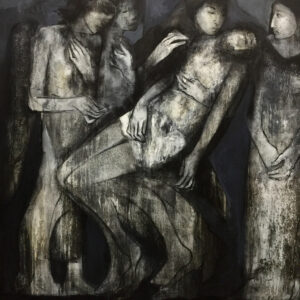














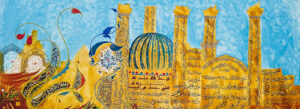








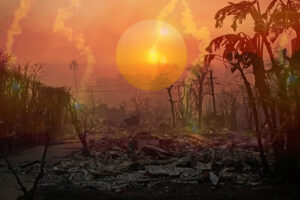








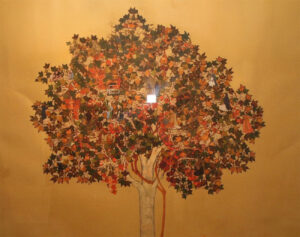

























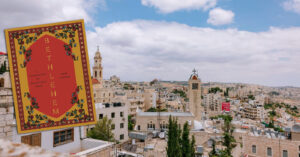





![Fady Joudah’s <em>[…]</em> Dares Us to Listen to Palestinian Words—and Silences](https://themarkaz.org/wp-content/uploads/2024/03/SAMAH-SHIHADI-DAIR-AL-QASSI-charcoal-on-paper-100x60-cm-2023-courtesy-Tabari-Artspace-300x180.jpg)















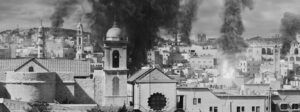















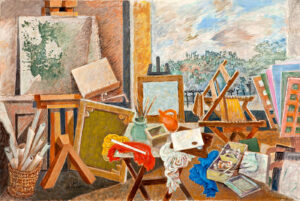





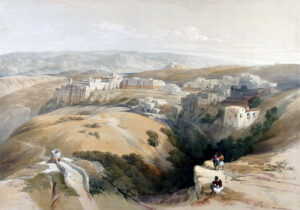











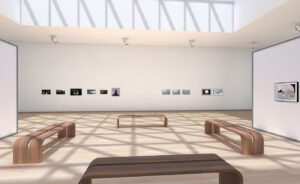




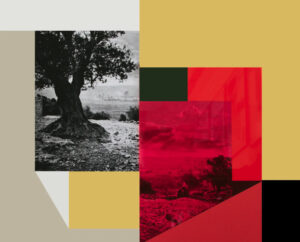








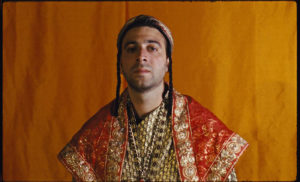































Hola!!, me encantan las historias alrededor de al-khird, sabes algo mas?, aun existen mas lugares sagrados de el verde?